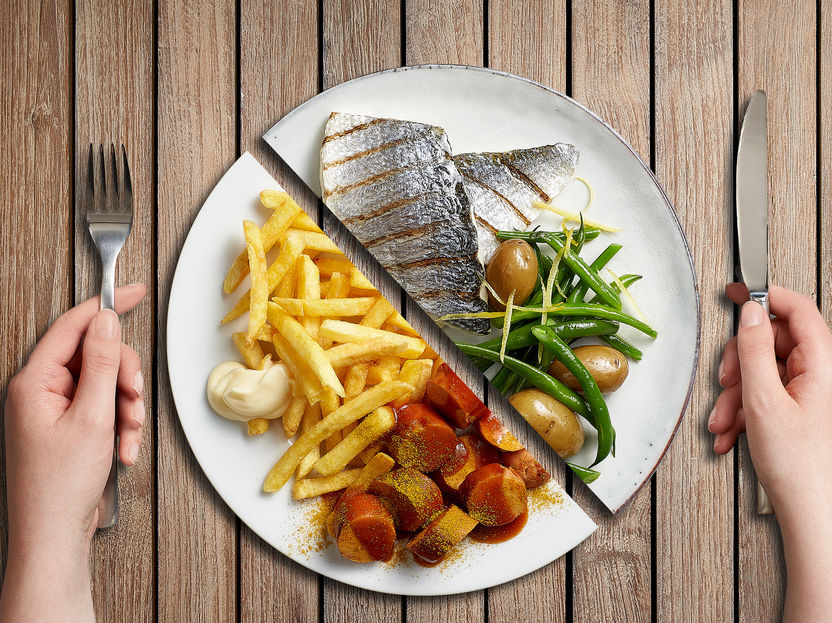Nestlé Study 2019: How divided is Germany?
The social gap is also reflected in eating habits
Advertisement
The dining table empty, the kitchen cold? The nutritional behaviour of people in Germany has changed more dramatically in the last ten years than was initially assumed. But Germany is (s)t more and more divided. It is not only women who eat differently from men - it is above all between the social classes that the scissors of eating increasingly diverge. At the same time, the role of food as a source of community is in danger of being lost more and more. "We will all eat differently in the future", asks the Nestlé study "So is(s)t Deutschland 2019", which has now been presented together with the Institut für Demoskopie Allensbach in Frankfurt am Main. The survey surveyed 1636 German citizens aged 14 to 84, whose statements were compared with the results of the first Nestlé study in 2009.

The dining table empty, the kitchen cold? The nutritional behaviour of people in Germany has changed more dramatically in the last ten years than was initially assumed. But Germany is (s)t more and more divided.
Nestlé Deutschland AG
"Food culture is becoming more and more heterogeneous. Nutrition is increasingly being adapted to individual needs and life situations. As a result, fixed habits dissolve and the demands placed on one's own nutrition, such as everyday nutrition, become more and more different," explains Professor Renate Köcher, Managing Director of the Allensbach Institute for Public Opinion Research. Köcher cited the increasing lack of time due to the rising employment rate, the de-structuring of daily routines as well as the generally increasing spontaneity and individualisation of society as the causes. In addition, there is a remarkable divergence in the nutritional behaviour of the various social strata. "We are using our findings from the study to adapt our portfolio to consumer demands - with a focus on convenience, health and ecological and social sustainability," says Marc Boersch, CEO of Nestlé Deutschland AG.
Is lunch disappearing?
A warm meal a day is the rule for fewer and fewer people in Germany. This only applies to 45 percent of those surveyed (2009: 55 percent). The main meal must also be lunch for fewer and fewer people. Ten years ago, 47 percent ate their main meal at noon, today only 39 percent. With dinner we almost reached a tie (38 percent). And lunch is increasingly taken outside the home. Ten years ago, 54 percent still ate at home at noon, compared with 42 percent at present. The same applies to daily cooking: only about half of the population (52 percent) now cooks every day. Just as many eat at fixed meal times (52 percent), a drop of ten percentage points here as well. The time taken to eat has also fallen by five percentage points in the morning, at noon and in the evening. To the same value increased the number of those who indicated to eat then when you just have time or hunger (34 percent).
Torn between high demands and everyday stress
People in Germany are under great time pressure, but their demands on food in terms of quality, health and freshness are growing. The desire to "eat healthily" has risen from 52 percent to 55 percent in ten years. To do justice to this, 13 percent more people today want to prepare their food fresh than in 2008. For mothers this is even 33 percent more. "Cooking to know what's in the food", that's what every second person says today, in 2008 it was 41 percent. But due to the lack of time and the de-structured everyday life, today's diet is more spontaneous, impulse- and opportunity-driven. Every third person says they usually decide spontaneously and eat when they have time or hunger. This presents people with the challenge of optimising their diet in the light of the time available.
More and more people eat alone
Common meals in the family are very important for the majority of the population (77 percent), and even more so for families with children (95 percent). They are communication islands and important moments for exchanging information, say 87 percent of the respondents. Nevertheless, the restructuring of society is leading to fewer and fewer joint meals during the week: in the last ten years, the number of joint meals for breakfast or dinner during the week has fallen by 5 percent, and joint lunches by as much as 9 percent. Consequence: During the week only every second person eats lunch together with others, only 39 percent have breakfast together.
The social classes eat more and more differently
For two out of three respondents, a good diet plays a large or very large role (65 percent). This value has hardly changed compared to ten years ago (63 percent). The difference can be seen in the increasing polarization: the value in high social strata has risen from 75 to 81 percent, while in weaker social strata it has fallen from 53 to 49 percent. The gap has thus widened by 10 percentage points in ten years and now stands at 32 percent. Conversely, the value of those who find that "too much fuss" is being made about the topic of nutrition has risen from 48 to 52 percent, but disproportionately from 54 to 66 percent among the socially weaker strata. Here, too, the gap has widened by 10 percentage points to 25 percentage points. Similar divergences can be found in almost all the nutritional attitudes surveyed: whether regionality, seasonality, the avoidance of artificial additives, species-appropriate animal husbandry, organic and eco-products, environmentally friendly packaging or fair trade. The attitude of the social milieus is now even more divergent than it was ten years ago.
Women eat healthier, men eat meat
The importance of nutrition also differs between the sexes: Good nutrition plays an important role for 72 percent of women, but only for 58 percent of men. Women pay much more attention to a balanced diet. For almost every second woman (48 percent), fruit and vegetables are simply part of their diet. Only about one in four men (27 percent) feels the same way. Men pursue significantly fewer goals with their diet than women. 18 percent stated that they did not pursue any goals at all with their diet. On the other hand, there are only half as many women (9 percent). Young people like to eat and eat more spontaneously than the rest of society. Even more than the total population (51 percent vs. 34 percent), 14- to 19-year-olds have no fixed mealtimes. They orient themselves more to what they like than to what is healthy. This is said by 62 percent, whereas the figure for the total population is 39 percent.
Nutrition is becoming more and more targeted - only the implementation is lacking
Despite many differences, the majority of people in Germany are united by the desire to achieve a concrete goal with their own diet. That's what 90 percent of respondents say. Their main motivations are fitness (60 percent), health (57 percent) and personal well-being (51 percent), closely followed by self-optimization (35 percent) and personal appearance (24 percent). This contrasts with the fact that the majority of people (85 percent) are not completely satisfied with their eating habits. Even though supply and choice have improved in ten years, just as many people are dissatisfied with their diet as in 2008. On average, Germans perceive four nutritional deficiencies: first and foremost evening cravings (33 percent), too little consumption of fruit and vegetables (31 percent), too fatty food (28 percent) or too little time to eat (25 percent). People see the responsibility for this primarily in themselves: Every second person says that he simply does not want to do without some things, even if he knows that it is not good for him. Only 5 percent consider the diet to be too unhealthy.
The restaurant as an escape from everyday life
Increasing visits to restaurants prove it: more and more people are eating out. One reason for this is the steadily rising employment rate of women and their new understanding of their roles. Two out of three women with children try to spend as little time as possible on cooking during the week, 18 percent more than in 2008 (47 percent). Instead, people increasingly eat in restaurants. On the one hand, because it means "less effort and they enjoy not having to worry about anything". That's what 50 percent of respondents say, but 59 percent of women say. On the other hand, more and more people are going to the restaurant for social reasons: every second person justifies their visit to the restaurant with the fact that it is a good opportunity to meet others. 42 percent say they eat out to have a good time and relax.
In the future: desire for relief and time saving
Consumers' needs are sometimes different from what they are supposed to be: although there is a lot of talk about climate protection, there is still a lot of talk about it. But only 5 percent of people in Germany would actually accept insects as a meat substitute. The willingness to order food over the Internet is also attractive to very few. In contrast, 43 percent of people in Germany would like intelligent packaging that provides information about the condition and freshness of the food. Kitchen robots, automatic recording of purchases at the checkout or intelligent refrigerators would please every fifth person. It is astonishing that innovations in the immediate food sector (such as foods that enhance mental performance or are tailored to the individual's genetic structure) are desired by only 15 percent and 9 percent, respectively. The desire to make shopping and food preparation easier and time-saving is therefore more important than the further development of the food itself.
Equal opportunities for good nutrition
"We take a critical view of the diverging social gap. We want to support all types of nutrition in implementing their personal goals and requirements. Nutrition should be uncomplicated, healthy and enjoyable with a clear conscience," says Marc Boersch, CEO of Nestlé Deutschland AG. "In the future, we want to be even closer to people's needs and support them in their everyday lives - with innovations, healthy convenience, services and information. As an example, Boersch cited the recently launched vegan "Garden Gourmet Incredible Burger", which combines convenience, health and sustainability.
Note: This article has been translated using a computer system without human intervention. LUMITOS offers these automatic translations to present a wider range of current news. Since this article has been translated with automatic translation, it is possible that it contains errors in vocabulary, syntax or grammar. The original article in German can be found here.



























































